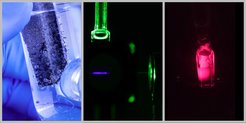Interaction of light and matter and vice versa the emission of light from luminophores are central to many energy transformations required to address global challenges towards a future sustainable energy economy. In addition to devising efficient energy conversion processes from a fundamental viewpoint towards applications, the materials designed must avoid precious and rare elements and rather employ earth-abundant elements.The Focus Group Sustainable Photochemistry and Photophysics provides a platform for scientists working in the fields of bioelectronics, data storage, Earth-abundant elements, energy conversion, energy storage, energy transfer, OLEDs, organic semiconductors, photocatalysis, photochemistry in water, photo-induced electron transfer, solar hydrogen, upconversion and water splitting among others. Synthesis, spectroscopy and computational groups are working together to achieve significant progress towards these overarching these goals.Important contributions in organic photoredox catalysis using abundant elements and materials [1] are the employment of Molecular Rubies in photoredox catalysis,[2] the photochemical alpha-aminonitrile synthesis using Zn phthalocyanines as near infrared photocatalysts,[3] the vinylcyclopropane [3+2] cycloaddition with acetylenic sulfones based on visible light photocatalysis[4] and the aerobic photobiocatalysis enabled by combining core-shell nanophotoreactors and native enzymes.[5] Recent examples for solar hydrogen production (Figure 1 left) include a photosensitizer-polyoxometalate dyad that enables the decoupling of light and dark reactions for delayed on-demand solar hydrogen production[6] and photoinduced charge accumulation and prolonged multielectron storage for the separation of light and dark reaction.[7] In the area of bioelectronics high‐performance bioelectronic circuits were integrated on biodegradable and compostable substrates with fully printed mask‐less organic electrochemical transistors.[8] Significant progress has been achieved in the field of photon upconversion with studies on efficient green-to-blue photon upconversion processes using abundant chromium(III) ions (Figure 1 middle and right),[9] Vis-to-UV upconversion with an excited annihilator singlet beyond 4 eV[10] and metal-free sensitizer for room-temperature triplet-triplet annihilation upconversion.[11] Several key reviews from Focus Group members appeared in the fields of earth-abundant metals in photocatalysis,[12] aqueous electron and energy transfer photochemistry[13] and the comparative evaluation of light-driven catalysis as a framework for standardized reporting of data.[14] Members of the Focus group are part of key collaborative research efforts, such as the TRR234 CataLight (https://www.catalight.eu), the priority program SPP2101 Light-Controlled Reactivity of Metal Complexes (https://www.spp2102.uni-mainz.de) and the Top-level Research Area of JGU Mainz SusInnoScience (https://susinnoscience.uni-mainz.de).Selected publications[1] N. R. East, R. Naumann, C. Förster, C. Ramanan, G. Diezemann, K. Heinze, Nat. Chem. 2024. Oxidative two-state photoreactivity of a manganese(IV) complex using near-infrared light [DOI: 10.6084/m9.figshare.24886530][2] S. Sittel, A. C. Sell, K. Hofman, C. Wiedemann, J. P. Nau, C. Kerzig, G. Manolikakes, K. Heinze,
Chem. Cat. Chem. 2023,
15, e202201562.
Visible-Light Induced Fixation of SO2 into Organic Molecules with Polypyridine Chromium(III) Complexes [DOI: 10.1002/cctc.202201562][3] C. Grundke, R. C. Silva, W. R. Kitzmann, K. Heinze, K. T. de Oliveira, T. Opatz, J. Org. Chem. 2022, 87, 5630-5642. Photochemical alpha-Aminonitrile Synthesis using Zn Phthalocyanines as Near Infrared Photocatalysts [DOI: 10.1021/acs.joc.1c03101][4] A. Luque, J. Groß, T. J. B. Zähringer, C. Kerzig, T. Opatz, Chem. Eur. J. 2022, 28, e2021043. Vinylcyclopropane [3+2] Cycloaddition with Acetylenic Sulfones Based on Visible Light Photocatalysis [DOI: 10.1002/chem.202104329][5] W. Wei, F. Mazzotta, I. Lieberwirth, K. Landfester, C. T. J. Ferguson, K. A. I. Zhang, J. Am. Chem. Soc. 2022, 144, 7320–7326. Aerobic Photobiocatalysis Enabled by Combining Core–Shell Nanophotoreactors and Native Enzymes [DOI: 10.1021/jacs.2c00576][6] S. Amthor, S. Knoll, M. Heiland, L. Zedler, C. Li, D. Nauroozi, W. Tobaschus, A. K Mengele, M. Anjass, U. S Schubert, B. Dietzek-Ivanšić, S. Rau, C. Streb, Nat. Chem. 2022, 14, 321-327. A photosensitizer–polyoxometalate dyad that enables the decoupling of light and dark reactions for delayed on-demand solar hydrogen production [DOI: 10.1038/s41557-021-00850-8][7] M. Schulz, N. Hagmeyer, F. Wehmeyer, G. Lowe, M. Rosenkranz, B. Seidler, A. Popov, C. Streb, J. G. Vos, B. Dietzek, J. Am. Chem. Soc. 2020, 142, 15722–15728. Photoinduced Charge Accumulation and Prolonged Multielectron Storage for the Separation of Light and Dark Reaction [DOI: 10.1021/jacs.0c03779][8] R. Granelli, I. Alessandri, P. Gkoupidenis, I. Vassalini, Z. M. Kovács‐Vajna, P. Blom, F. Torricelli, Small 2022, 2108077. High‐Performance Bioelectronic Circuits Integrated on Biodegradable and Compostable Substrates with Fully Printed Mask‐Less Organic Electrochemical Transistors [DOI: 10.1002/smll.202108077][9] C. Wang, F. Reichenauer, W. R. Kitzmann, C. Kerzig, K. Heinze, U. Resch-Genger, Angew. Chem. Int. Ed. 2022, 61, e202202238. Efficient Triplet-Triplet Annihilation Upconversion Sensitized by a Chromium(III) Complex via an Underexplored Energy Transfer Mechanism [DOI: 10.1002/anie.202202238][10] T. J. B. Zähringer, M.-S. Bertrams, C. Kerzig, J. Mat. Chem. C 2022, 10, 4568–4573. Purely organic Vis-to-UV upconversion with an excited annihilator singlet beyond 4 eV [DOI: 10.1039/D1TC04782E][11] A. Vasilev, A. Kostadinov, M. Kandinska, K. Landfester, S. Baluschev, Front. Chem. 2022, 10, 809863. Tetrathienothiophene Porphyrin as a Metal-Free Sensitizer for Room-Temperature Triplet-Triplet Annihilation Upconversion [DOI: 10.3389/fchem.2022.809863][12] W. R. Kitzmann, K. Heinze, Angew. Chem. Int. 2022, in press. Charge-Transfer and Spin-Flip States: Thriving as Complements [DOI: 10.1002/anie.202213207][13] M. Schreier, X. Guo, B. Pfund, Y. Okamoto, T. Ward, C. Kerzig, O. S. Wenger, Acc. Chem. Res. 2022, 55, 1290–1300. Water-Soluble Tris(cyclometalated) Iridium(III) Complexes for Aqueous Electron and Energy Transfer Photochemistry. [DOI: 10.1021/acs.accounts.2c00075][14] D. Ziegenbalg, A. Pannwitz, S. Rau, B. Dietzek-Ivanšić, C. Streb, Angew. Chem. Int. Ed. 2022, 61, e202114106. Comparative Evaluation of Light-Driven Catalysis: A Framework for Standardized Reporting of Data [DOI: 10.1002/anie.202114106]

